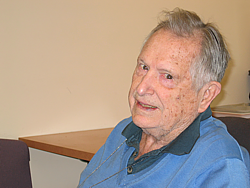Dr Brian Mason – an appreciation

Dr Brian Mason has died in America, aged 92. A New Zealander, he was awarded a grant to study in Norway under V M Goldschmidt, and went there in early 1939. When Norway was invaded, he escaped to Sweden, and was taken in by Percy Quesnel of Stockholm, to work on quite different mineralogical research. Goldschmidt crossed later to Sweden, and Brian was secretly taken to be reunited. He was awarded his doctorate by the Swedish monarch. Sweden, although neutral, was flying ball-bearings secretly to Aberdeen and in 1943, Brian got to Britain by air with them, and back to New Zealand in 1944. (Goldschmidt also got to Aberdeen.)
After a lecturing career – he could lecture ‘at the drop of a hat’ – he went to the USA and was appointed curator of minerals at the American Museum of Natural History, where his first work was on meteorites. He moved later to the Smithsonian as curator of meteorites. He wrote a brilliant book about them and carried out many important researches, especially on the Allende (Mexico) fall. At the age of 55, in 1976, he really came into his own with the USA Antarctic programme, following the initial Japanese finds in Yamato Mountains in 1969, and he is reported to have examined thin sections of, and described, every stony meteorite, brought back to the Smithsonian, where thin sections of every one were delivered.
I myself fell by chance into the role of part-time unpaid curator of meteorites, with John de Laeter, in 1962 at the Western Australian Museum. Ireceived nothing but generous help and encouragement from Brian: he was a lovely, kind man, always good company and most entertaining in conversation. He inspired me to maintain a lifelong interest in meteoritics as well as the more usual preoccupations of geologists. I have lost a great friend.